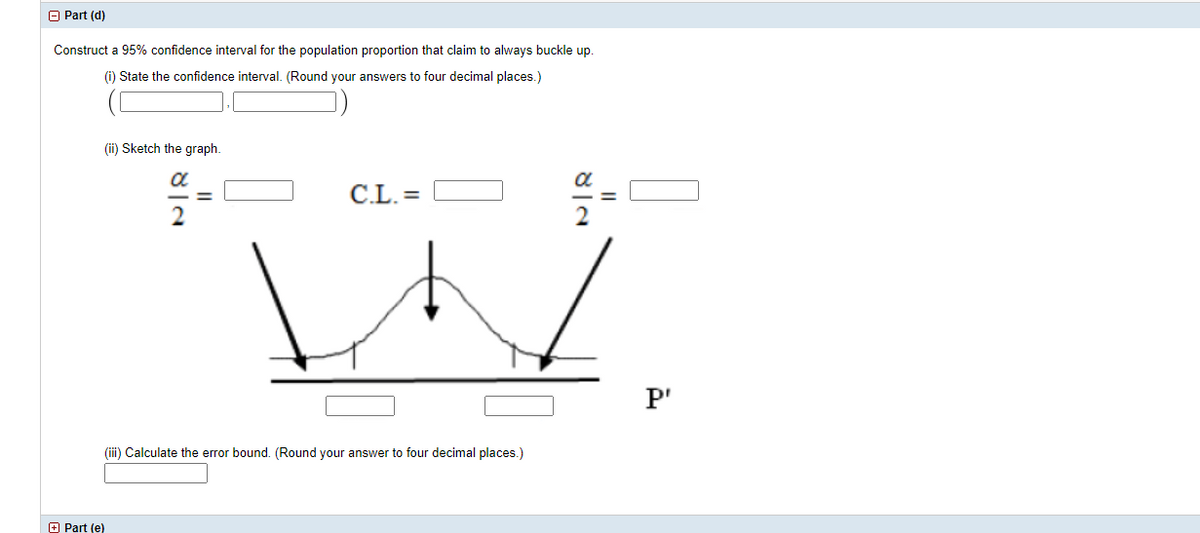Construct a 95% confidence interval for the population proportion that claim to always buckle up. (1) State the confidence interval. (Round your answers to four decimal places.) (ii) Sketch the graph. a C.L. = 2 2 P' (ii) Calculate the error bound. (Round your answer to four decimal places.)
Construct a 95% confidence interval for the population proportion that claim to always buckle up. (1) State the confidence interval. (Round your answers to four decimal places.) (ii) Sketch the graph. a C.L. = 2 2 P' (ii) Calculate the error bound. (Round your answer to four decimal places.)
MATLAB: An Introduction with Applications
6th Edition
ISBN:9781119256830
Author:Amos Gilat
Publisher:Amos Gilat
Chapter1: Starting With Matlab
Section: Chapter Questions
Problem 1P
Related questions
Question

Transcribed Image Text:Suppose that insurance companies did a survey. They randomly surveyed 450 drivers and found that 300 claimed to always buckle up. We are interested in the population proportion of drivers
who claim to always buckle up.
NOTE: If you are using a Student's t-distribution, you may assume that the underlying population is normally distributed. (In general, you must first prove that assumption, though.)
O Part (a)

Transcribed Image Text:A Part (d)
Construct a 95% confidence interval for the population proportion that claim to always buckle up.
(i) State the confidence interval. (Round your answers to four decimal places.)
(ii) Sketch the graph.
a
C.L. =
2
2
P'
(ii) Calculate the error bound. (Round your answer to four decimal places.)
O Part (e)
Expert Solution
This question has been solved!
Explore an expertly crafted, step-by-step solution for a thorough understanding of key concepts.
This is a popular solution!
Trending now
This is a popular solution!
Step by step
Solved in 3 steps with 6 images

Knowledge Booster
Learn more about
Need a deep-dive on the concept behind this application? Look no further. Learn more about this topic, statistics and related others by exploring similar questions and additional content below.Recommended textbooks for you

MATLAB: An Introduction with Applications
Statistics
ISBN:
9781119256830
Author:
Amos Gilat
Publisher:
John Wiley & Sons Inc

Probability and Statistics for Engineering and th…
Statistics
ISBN:
9781305251809
Author:
Jay L. Devore
Publisher:
Cengage Learning

Statistics for The Behavioral Sciences (MindTap C…
Statistics
ISBN:
9781305504912
Author:
Frederick J Gravetter, Larry B. Wallnau
Publisher:
Cengage Learning

MATLAB: An Introduction with Applications
Statistics
ISBN:
9781119256830
Author:
Amos Gilat
Publisher:
John Wiley & Sons Inc

Probability and Statistics for Engineering and th…
Statistics
ISBN:
9781305251809
Author:
Jay L. Devore
Publisher:
Cengage Learning

Statistics for The Behavioral Sciences (MindTap C…
Statistics
ISBN:
9781305504912
Author:
Frederick J Gravetter, Larry B. Wallnau
Publisher:
Cengage Learning

Elementary Statistics: Picturing the World (7th E…
Statistics
ISBN:
9780134683416
Author:
Ron Larson, Betsy Farber
Publisher:
PEARSON

The Basic Practice of Statistics
Statistics
ISBN:
9781319042578
Author:
David S. Moore, William I. Notz, Michael A. Fligner
Publisher:
W. H. Freeman

Introduction to the Practice of Statistics
Statistics
ISBN:
9781319013387
Author:
David S. Moore, George P. McCabe, Bruce A. Craig
Publisher:
W. H. Freeman